- News
- Reviews
- Bikes
- Components
- Bar tape & grips
- Bottom brackets
- Brake & gear cables
- Brake & STI levers
- Brake pads & spares
- Brakes
- Cassettes & freewheels
- Chains
- Chainsets & chainrings
- Derailleurs - front
- Derailleurs - rear
- Forks
- Gear levers & shifters
- Groupsets
- Handlebars & extensions
- Headsets
- Hubs
- Inner tubes
- Pedals
- Quick releases & skewers
- Saddles
- Seatposts
- Stems
- Wheels
- Tyres
- Tubeless valves
- Accessories
- Accessories - misc
- Computer mounts
- Bags
- Bar ends
- Bike bags & cases
- Bottle cages
- Bottles
- Cameras
- Car racks
- Child seats
- Computers
- Glasses
- GPS units
- Helmets
- Lights - front
- Lights - rear
- Lights - sets
- Locks
- Mirrors
- Mudguards
- Racks
- Pumps & CO2 inflators
- Puncture kits
- Reflectives
- Smart watches
- Stands and racks
- Trailers
- Clothing
- Health, fitness and nutrition
- Tools and workshop
- Miscellaneous
- Buyers Guides
- Features
- Forum
- Recommends
- Podcast
TECH NEWS
Updated: First ride: Shimano Ultegra Di2
We’ve just had our first ride using Shimano’s new Ultegra Di2 digital shifting and here’s the big news: in terms of function, you really can’t tell the difference between this and the twice as expensive Dura-Ace version.
We’re currently out in Switzerland where Shimano are letting us press layabouts play with the new equipment for the first time. They showed it to us ages ago, but now is the first time we’ve actually had the chance to give it a go, and initial impressions are excellent.

The Ultegra dual control levers are the same shape as the Dura-Ace ones and the shifting action is exactly the same too. Shimano describe it as, “Light and easy, like clicking a mouse,” and that’s about right – upshifts and downshifts are each achieved by pressing one of the levers tucked behind the brake levers a matter of millimetres.
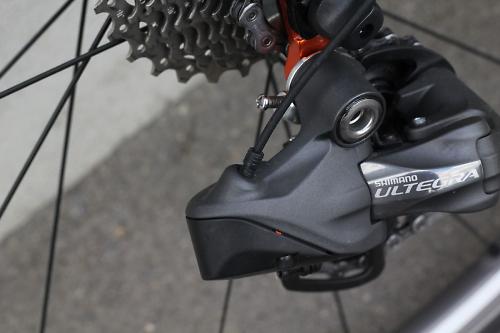
The rear mech is the same shape as the Dura-Ace version too, and it comes with a crash saver function that disconnects the motor if you stack to prevent further damage. It can handle a maximum sprocket size of 28-tooth, and you can pair that up with a 52-39T or 53-39T chainset, or go for a compact 50-34T option for a low set of gear ratios to get you up the steep stuff.

The front mech offers quick, silent shifting and it’s been perfectly accurate so far. Shift across the cassette and it’ll automatically adjust to avoid any chain rub, even if you’re on the big ring and big sprocket at the same time, or small and small… Not that you’d want to do either, but if you do, the system won’t go mental on you.
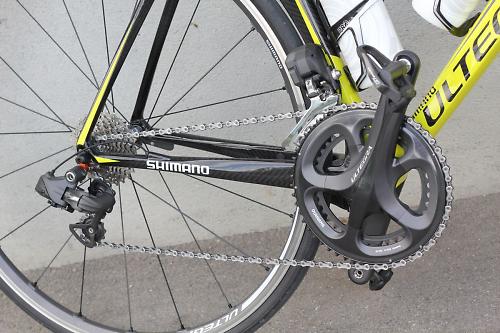
Two of us (Mat and Dave) have both spent precisely 1:15hrs each on the new Ultegra Di2 so we’re not saying these are anything other than initial impressions so far, but we did our best to confuse it with multiple shifts in each direction, changing front and rear at once, changing under heavy pressure out of the saddle… everything we could think of, and it didn’t care a bit. It seemed to be saying, “Pah! Is that all you’ve got?” It really is incredibly smooth and effortless.
We’ll dream up some more hardcore stupidity tonight to try out on tomorrow’s ride, though. That’s what we do best.
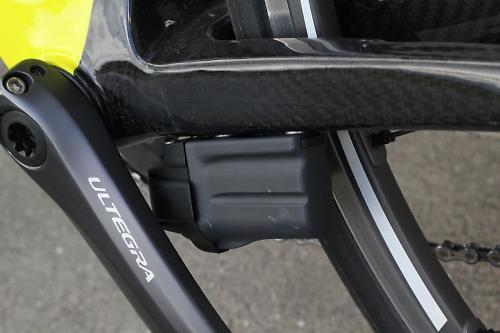
The Ultegra Di2 battery is the same as the Dura-Ace one, and it’ll give you upwards of 625 miles (1,000km) of use per charge. It’ll depend on how much shifting you do, obviously, but in reality you’re likely to get maybe three times that distance before you need to juice it up again from the mains.
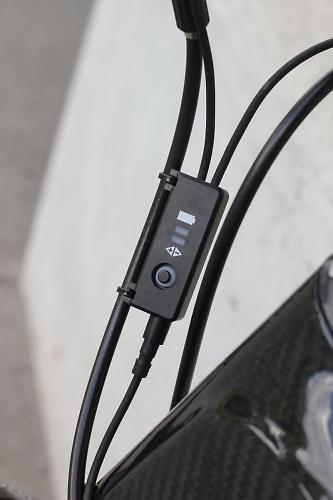
There really is no reason for you ever to run out of power unexpectedly. Battery indicator lights tell you how much is left in the tank and you get tons of warning before it actually runs out. Even then, the front mech stops working before the rear to give you a sporting chance of getting home with your quads intact.
The Ultegra Di2 system weighs a little more than the Dura-Ace but really not much more – 2,482g complete, against 2,219g. A Dura-Ace mechanical set-up, for comparison, is a little lighter again at 2,149g, while an Ultegra mechanical system is 2,402g.
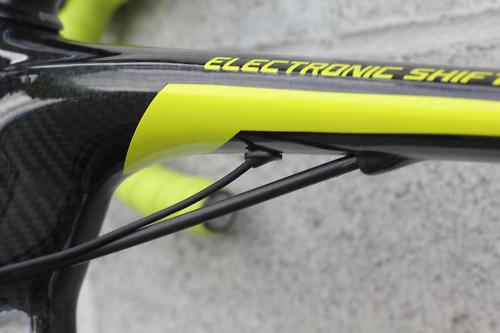
The other difference between Dura-Ace and Ultegra Di2 is in the cabling. The Ultegra version uses what Shimano are calling Etube cables which have two core wires instead of Dura-Ace’s four, a smaller diameter (5.1mm) and smaller connectors. That means that Dura-Ace and Ultegra are not compatible; you can’t run Dura-Ace shifters with Ultegra mechs.
The skinnier cables means that manufacturers can use smaller holes in their frames for running them internally… Not that you have to run the cables internally, you can fit them externally if you fancy making the change from mechanical to digital shifting on your current bike.
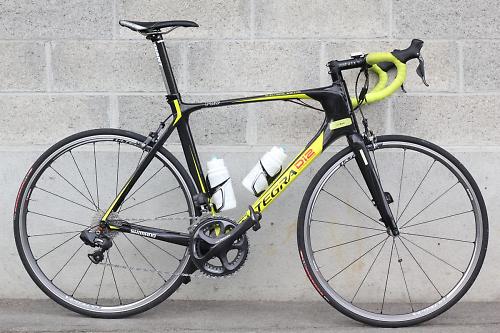
Shimano reckon that setting a bike up with Ultegra Di2 is easier that fitting a mechanical system. We’ve not tried it so we can’t comment on that. They also say that the connectors are immediately waterproof – you just plug them in and that’s it. We can’t comment on that either because the weather’s pretty good out here in Switzerland, but there are a few dark clouds coming in over the mountains so maybe we’ll find out in the morning.
Update
Okay, so now two of us from road.cc have had a bit more time riding with Ultegra Di2 I’ll update and clarify a few things. We’ve each spent about 6hrs using the system and ridden up and down a couple of fairly big Swiss mountains. That’s nowhere near enough time for a full test, but enough to get a feel for it. See Dave’s story too.
Weight
First, a few more background details… Here are the key weight differences between Shimano’s electronic and mechanical shifting systems:
Rear mech Mechanical Ultegra 189g, Ultegra Di2 270g, mechanical DA 166g, DA Di2 225g
Front mech Mechanical Ultegra 89g, Ultegra Di2 165g, mechanical DA 67g, DA Di2 124g
Shifters Mechanical Ultegra 447g, Ultegra Di2 313g, mechanical DA 379g, DA Di2 255g
Other parts Mechanical Ultegra 94g, Ultegra Di2 155g. mechanical DA 94g, DA Di2 172g
The battery and control box
Lights on the control box, which is attached to a cable at the front end, tell you how much charge is left in the battery. You get red and green lights, which are either constant or flashing, to tell you how much is left in there.
Worries about running out of juice are groundless. If you can keep a mobile phone topped up or put fuel in your car, you will be able to cope. You’ll have weeks or months of leeway here.
Shimano reckon the recharge time is about 90mins and they guarantee 500 charges per battery so you should never need to change it.
Diagnostics
Shimano have a new diagnostics system for the Ultegra Di2 system, although the price (yet to be confirmed) means it’ll probably only make economic sense for shops to own it. It’s a user interface that loads onto a PC. You connect your bike to the computer via a cable from one of the shifters and it’ll diagnose where any problem is in the Di2 setup.
You can also use this interface to change the way the shifters work. So, you can choose which of the two buttons moves you up a gear, and which one moves you down. You can also choose which shifter controls each mech.
I can’t imagine too many people moving to left-hand rear-mech shifting. If Shimano didn’t offer that, they could have just one button on the left-hand shifter that moved you to whichever chainring you're not currently in. They actually have two buttons, so you need to remember which is for upshifts and which is for downshifts. Loads of people kept forgetting on our test rides, but I imagine it would become automatic after a few days. Also, maybe a development of this system will allow Shimano to offer Di2 as a triple chainset option in the future… although that is speculation.
Waterproof
Shimano reckon Ultegra Di2 is completely waterproof. They say it’ll be fine even if you’re driving along the motorway in the rain with your bike attached to a rack.
Price
Exact prices have yet to be announced but Shimano tell us that Ultegra Di2 will be cheaper than mechanical Dura-Ace… although we’re not sure if that’s for just the electronic shifting system or for an entire groupset. In other words, Shimano haven’t told us whether savings made on Ultegra brake callipers over Dura-Ace equivalents, for example, are used in this calculation to produce a lower overall price than mechanical DA, or whether it’s like-for-like on the shifting system only. We’re trying to get that clarified at the moment.
What’s the point?
We’ve had a few people ask why you need Di2. The answer is that you don’t, and we’re not here to convince you that you do.
I would say that individual shifts using Di2 are a little easier than using a mechanical setup. Of course, shifting using a mechanical setup isn’t hard in the first place, but touching a button is a tad simpler than swinging a lever across, especially when you’re out of the saddle and giving it full beans. It’s like the difference between using, I don’t know, Shimano’s RapidFire shifters on a mountain bike as opposed to old-style thumbies… It’s not going to change the way you live your life, but it’s just a touch easier. You don’t need power-assisted steering in a car, but it makes life a little bit easier.
Multi-shifts across the cassette on a Di2 system take a bit of getting used to. Rather than one long sweep of a lever, you have to tap the button several times. You get used to it pretty quickly though… and most of your shifts will be one sprocket at a time anyway.
Could Di2 break and leave you stranded miles from home? It could doubtless stop working, particularly if you crash – things do – so in theory you could find yourself riding home on a singlespeed. So if you don’t think Di2 is for you, fine. Shimano really aren’t going to stop doing mechanical-shifting any time soon; you can rest assured on that one.
Here’s Shimano’s full rationale as given in their recent press release:
Professional riders have been using the Shimano Dura-Ace components with Di2 electronic shifting technology in the biggest races in the world over the past four years: over the highest mountains, in the most extreme weather conditions and over the worst possible roads and cyclo cross tracks. Now it is time to introduce this revolutionary technology into Shimano Ultegra, making it available to a much wider group of road racers and enthusiasts. The advantages of Di2 (Digital Integrated Intelligence) are clear for everybody who has tested it: changing gears becomes easier, effortless and faster by simply touching the shift buttons. Control at the tip of your fingers. Additional benefits include an automatic trimming front derailleur, unmatched precision plus super easy installation and adjustment. Shimano Ultegra 6770 series with Di2 technology consists of Dual Control Levers, electronically operated front and rear derailleurs, a battery and electric cables. For the remaining components – like Hollowtech II crankset, brake callipers, cassette sprockets and chain – you can rely on the products of the mechanical Shimano Ultegra 6700 component group. The electric cables include only two core wires (Dura-Ace Di2 has four) and the connectors are smaller too with a diameter of 5.1mm (-3.7mm compared to Dura- Ace Di2). Easy plug and play system to connect the cables, which will be available in different lengths to accommodate most frame dimensions. Connection with PC for diagnosis and changing the shifting order: The SEIS (Shimano Electronic Intelligence System) is based on the Shimano Index System (SIS) that has proved its superior gear changing characteristics over the years. The big difference is that in this case, the shifting action is provided for by electronics instead of mechanics. Ultegra 6770 products will exclusively become available in the new glossy grey colour. The products are not compatible with Dura-Ace Di2.
Mat has been in cycling media since 1996, on titles including BikeRadar, Total Bike, Total Mountain Bike, What Mountain Bike and Mountain Biking UK, and he has been editor of 220 Triathlon and Cycling Plus. Mat has been road.cc technical editor for over a decade, testing bikes, fettling the latest kit, and trying out the most up-to-the-minute clothing. He has won his category in Ironman UK 70.3 and finished on the podium in both marathons he has run. Mat is a Cambridge graduate who did a post-grad in magazine journalism, and he is a winner of the Cycling Media Award for Specialist Online Writer. Now over 50, he's riding road and gravel bikes most days for fun and fitness rather than training for competitions.
Latest Comments
- mpdouglas 25 min 7 sec ago
Based on the way they are ridden around London, the following would work well on the game show Jeopardy: Answer: A way of telling the world you are...
- hawkinspeter 26 min 19 sec ago
Probably because they've been using it for 30 years and not received any complaints until the DVLA sprung this on them....
- jaymack 27 min 10 sec ago
A lab in your hand but no cash in your pocket. But the app' is free which of course makes all the difference.
- the infamous grouse 37 min 30 sec ago
or for tyre manufacturers to give the distance from bead-to-bead. then, using the internal rim width measurement as chord length, one can calculate...
- HLaB 51 min ago
I'm not quite sure how you get bikes into Pottyboro's recycling centre, it a pretty car orientated layout with a sharp ramp up into a building of...
- anotherflat 1 hour 43 min ago
I cannot see how the type of cycle lane has any bearing on cars pulling out in front of you....
- Louis Wells 2 hours 41 min ago
it would be funny if a judge could ban the passenger from driving (if licenced) and give them an asbo preventing them form being a passenger in a...
- mark1a 3 hours 23 min ago
Posting them here in the comments six times a day is just excessive anyway.



















Add new comment
33 comments
Tony, you ain't gonna c0nvince someone who just dont wan to listen.
To be fair, I had the same sort of prejudice about electric bikes until a patent lawyer friend of mine (he's prob reading this, so I'm buffing his ego not showing off!) commented that anything that helped more people ride bikes had to be a good thing... and with that I agreed.
hmm yes, but it does cause chain wear even if it's the wrong sort of chain wear. I'm not sure that your point about extreme chain lines is that valid these days either, but I'll come back to that when it isn't Friday night.
On the subject of unnecessary & ecologically unsound batteries on bikes… do you really need that handlebarcam on yours?
erm… that's the point it means there isn't a gear combination that should not be used.
As for the £179.99 for the cables why would you need to change them? They are not going to stretch or wear out - how often do you replace the power cable on your TV or the wiring loom in your car (okay, maybe you don't have a car)? Bet the ticket price on the latter of those two would be fairly eye-watering as well.
In fact, given enough time Ultegra Di2 should pay for itself in saved re-cabling costs and less wear to your chain and cassete… obv it might take a bit of time though.
It isn't rubbing against an untrimmed front mech that causes chain wear, at least not the kind of wear - elongation - that itself causes cassettes to wear out prematurely. It is running big-big or small-small combinations. In those gears the link coming off, or mating with, the sprocket teeth is put under unnecessary strain.
Because we can. Hence; electric winders in car doors for the windows; a microwave instead of a gas stove (or a camp fire, for that matter); mobile phone instead of a letter; a computer... The list is near endless when you start to think about it.
This may not be the most useful innovation ever, but getting all sniffy just because its on a bike is what prevents real progress.
Look what happened to Obree - one of the greatest innovators cycling has seen in years - but for his bloody-mindedness, he would have been trampled by sniffy snobs who didn't like how his bike looked. And where would TT bikes be without his input?
And I did say you proles just wouldn't understand.
Its better because on a tt bike you change gears in both positions which for me is quite a big thing especially on technical courses.
The shifting should not get worse following lots of miles in crap conditions. Again for me while not essential is a big bonus. I find after a thousand miles( about a month) my shifting goes down hill. Its not so bad I can be bothered to change the cables but its not perfect even though I check/replace the block and chain as needed
I don't understand. What problem does it solve? What does it do better than a mechanical mech? What is the point, other than 'because we can'?
It doesn't solve a problem as such but it does do the job better, especially at the front and the auto trim function means you've always got the best chainline which should reduce wear for both the chain and the rear cassete. Marginal gains perhaps, but gains nonetheless
What has trimming got to do with chainline? It will allow gear combinations that should not be used, and which would increase wear. But then anyone stupid enough to pay 200 quid for a set of cables isn't going to be too worried about replacing their chain or cassette more frequently.
that sounds a lot like someone talking about STI levers in 1991
Interesting debate on effectiveness vs efficiency. For a really efficient bike, surely you should ride one with only one gear? Less to go wrong, meaning fewer parts being shipped. Gears aren't 'necessary' really, they are just pretty useful in certain situations. I guess different people have different views on what counts as 'useful enough to justify inefficiency'.
Out of interest, I take the point that metal bike parts could be recycled, but does anyone know where it is possible to recycle old bike mechs and shifters? I find a lot of companies claiming that their products are now 100% recyclable, but finding somewhere to actually recycle them is another matter...
My issue is I think too many of us can occasionally be led into buying stuff we 'need' when actually we just want it because someone tells us it's nice. There's nothing wrong with that but how may things like the iPad (another consumer item that has created a market for itself) are being bought on the never never...just because its nice. I think as cyclists we are all guilty to some degree. We're suckers for technology and fashion right? Who's completely happy with bike and gear? Anyway I could go on about materialism-driven crime and the credit crunch etc but this article is about a groupset. I agree the motors being too bulky.
Like it or not, electronic shifting is the future and this latest move by Shimano is simply market forces at work - if you don't innovate in a competitive marketplace, you die.
You may not want it or be able to afford it but that's hardly Shimano's fault is it?!
The bigger housings on the mechs caused by the big S using off the shelf motors do make it look a little crummy IMHO but not too bad.
I'd suggest that in comparison to mobile phones/tablets/laptops/digg cameras/MP3 players the number of extra batteries that will be made to accomodate the uptake of electronic sshifting will be VERY small. Oh and don't forget, when you are on your bike (the most efficient form of transport apparently) at night you might be using batteries? But then again you probably use a dynamo or don't use lights.
I agree with your sentiment, but can't go along with your high handed moral "superiority". Don't you have goats to milk?
yeah, thats what struck me first time i saw it, esp. the front mech.. will certainly loose you a few 'marginal gains' when set up on your aero bike..
environmentally sound or not by the time i save up enough cash i expect the 105 Di2 group will be available.
That's not the point. Batteries are not incongruous in the context of those kinds of electronic gadgets. In fact, other than Trevor Baylis's clockwork radio, which might substitute for an MP3 player, they are essential.
Yes, but lights are not a permanent part of the bike. Occassionally adding battery-powered lights to a bicycle does not undermine the intrinsic efficiency of the bicycle. Integrating battery-powered motors into the gear system does.
I never said I was morally superior. Bicycles are superior in terms of energy conversion into miles travelled. That's not my opinion, it's just a fact you can calculate or Google for. They can be 100% recycled and they require no consumption of non-renewable resources. Muddying that purity by incorporating a battery that must be charged and cannot be recycled, and motors that probably contain rare earth metals, is, in a subtle but important sense, a backwards step. That is all I am saying.
Who said anything was Shimano's fault? They have every right to sell electronic groupsets. I have every right to argue against their use.
I have used Di2 and I want it! In fact I am getting it for the tt bike
Awesome. Finally makes Shimano road gruppos attractive (always hated their crappy front mech trimming and unstable feeling moving brake lever).
Does anyone know what frame Shimano have badged up there? Giant or just a generic carbon frame from a Taiwanese factory?
Yup, Giant Advanced. Dave has written about it here: http://road.cc/content/news/40599-first-ride-giants-2012-tcr-advanced-frame
I'm sure it's all very nice but lets not get carried away with the sexy marketing (albeit with a lime green motif). How will it make any difference to anyone on here compared to a well set up mechanical system? Even if trimming a mech isn't your strong point £20 for a service at the LBS every so often is still a lot less. Technology for technology's sake I think but then that's a natural consequence of a market for a machine that hasn't materially changed in design for many a year. Sadly, things break; normally at the worst time possible. I wouldn't know where to start with bodging one of these to get me home...**ludite mode off** Sorry I just don't get it.
Jebus. Yes, because all those manual-shifting aluminium and carbon components, not to mention frames, have no environmental impact at all. I mean, Ultegra STis just come out of the ground like that, and break down in a matter of hours in your compost bin.
I'm guessing you didn't do too well in reading comprehension lessons at school? Notice the word "unnecessary" I included before the word "pollution"? The environmental impact of frames and non-electric components (probably non-carbon too) is necessary if you are going to ride a bike at all. And because, as I also said, cycling is the most efficient form of transport, the only way to reduce your impact further would be subsist on some self-sufficient small holding, never going anywhere. But slapping batteries and motors on your bikes, to get a dubious microsecond advantage in a sprint, or because you are too feeble to change gears at the end of a long sportive, causes additional, excessive, superfluous environmental impact: i.e. as I said rather more concisely in my previous comment: unnecessary pollution.
But it is the ethos that really concerns me.
Well, our modern economy depends on people buying more and more 'stuff' so that's what companies provide (and they spend a fortune on advertising to convince us it's a good idea). Shimano isn't alone in this.
I am not sure I would put electronic gear shifting alongside motorcars and similarly polluting items. Anyway, lots of cyclists aren't buying their bikes for environmental reasons. For instance, most people who enter sportives and time trials or ride at trail centres get there in a car. It's not as if a small battery and some bits and pieces on a bicycle will make much difference to the stability of the Greenland ice shelf.
A knee-jerk reaction to electronic shifting could look like a repeat of the claims that indexed shifting was a dreadful thing and suitable only for fools. I can see advantages compared to mechanical setups and if people want to use it then I don't have a problem with that though I would prefer not to rely on a battery-driven device to manage the gears on my bike.
Sorry, no. If I wanted ugly and noisy electric motors, batteries that cause unnecessary pollution both to manufacture and to dispose of when they inevitably stop being able to hold a charge, and non-user-serviceable, non-interoperable components - I'd buy a Nissan Leaf. Electric shifting epitomises the current trend for choosing effectiveness over efficiency, along with the private motorcar, oil wars, and high-yield bond trading. Bicycles represent the exact opposite.
I totally agree.
Naturally, I only ride a wooden bicycle fitted with a single fixed sprocket. Well, any advance on the first bicycle 'epitomises the current trend for choosing effectiveness over efficiency' that never occurred in 'my day' - the 'good old days'.
Unfortunately, I have to take my rose tinted spectacles off to read these posts but, before you start, my PC is powered by solar panels and being made of folded banana leaves helps save the planet.
Of course, its real tough out there with these high morals, especially when I puncture and can't find a local rubber plantation in order to buy locally sourced rubber to repair my tyres.
I could go on, but you proles will never understand...
Looks pretty ugly. Looking forward to Campy's. : )
Looking for an excuse to remortgage are we?
Since when has the abbreviation 'Campy' been allowed on these shores?
Since Campy started using the term themselves?
Pages